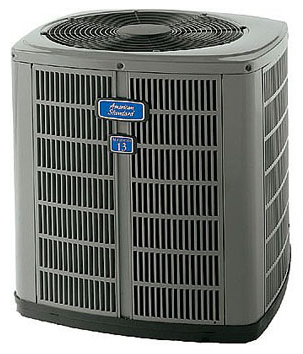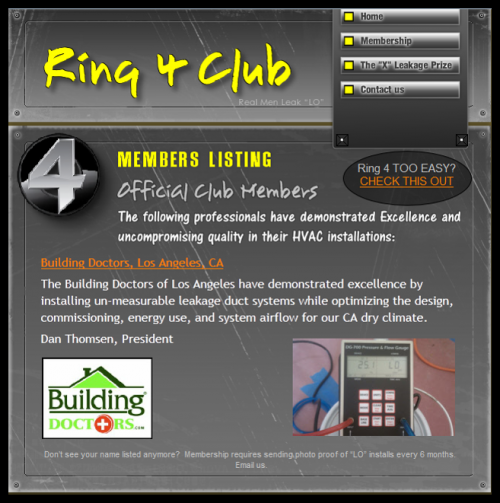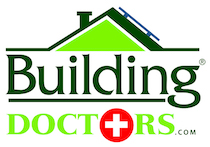 Are you building a new home and deciding on air conditioning? Are you thinking of installing air conditioning in your current home? There are several pitfalls you should know about that can reduce the efficiency of even the best units by half, resulting in warm, humid spots and higher utility bills.
Are you building a new home and deciding on air conditioning? Are you thinking of installing air conditioning in your current home? There are several pitfalls you should know about that can reduce the efficiency of even the best units by half, resulting in warm, humid spots and higher utility bills.
The first problem to guard against is oversizing an air conditioner. 99% of all of the comprehensive energy audits that Building Doctors has completed have had oversized air conditioning condensers. On first thought, this would seem like a good idea – how can you have too much cold?
There are three reasons:
First is that an air conditioner is most efficient the longer it runs. If it is too big, it will run for a couple of minutes at a shot, whereas, if it is the right size, it will run much longer – on the hottest afternoons of the year, it should run all the time. This delivers the cold air at the lowest cost and more evenly.
The second is that the air conditioner is also a dehumidifier. Here on the West Coast we spend about 20% of our air conditioning money on taking moisture out of the air. If the unit is too big and spends more time off than on, the coils won’t get cold enough for a long enough period of time to condense enough moisture to be effective in removing moisture from the air.
The third problem with oversizing the air conditioner is that if you buy too big a unit, you are simply wasting money. A properly sized unit has a fudge factor built-in, so that once a proper heat loss/gain calculation has been done, buying a larger unit than called for is unnecessary.
In addition to oversizing the unit, there are other factors that can spoil an installation.
Another factor that we find in the majority of homes in Southern California are under-sized returns. A properly sized return for an air conditioning system is two square feet of return area per ton of cooling. The return is what brings the air in your home back into the ducting and to the forced air unit. It is either cooled down in the summer time and warmed up in the winter time. In order for the air to be cooled down properly it need enough surface area for the air to pass over the coils. Imagine running a marathion while wearing a snorkle? It makes the rest of your systems work harder and eventually shortens the life of the unit and makes it run less efficiently.
You can’t have a high efficiency system with low efficiency ducts. Ducts that run outside the thermal envelope, in attics and crawlspaces, typically have R-4 insulation installed. Compare this with your R-13 walls and R-30 attics! Any ducts that run in unconditioned spaces should be sealed tight and insulated to at least the level of the surrounding areas – R-38 would be desirable. We do this by running your ducts along the attic floor then deep burying the ducts in your attic with insulation. This helps protect the air inside the ducts for the outside temperatures.
The location of the air handler is also very critical. We try to locate the forced air unit in the center of the either that attic or crawl. Then we can have short straight duct runs to each room that we install a register. System design is critical to run at peak efficiency.
If ducts are in unconditioned spaces, duct leakage can introduce hot, humid, dirty air to the system if it is on the return side. Supply side leakage just blows expensive cold air to the outside. So sealing these duct systems as tight as possible is a very good idea. Current code in California allows 15% leakage on existing HVAC systems and 6% on newly installed HVAC systems. We at Building Doctors think this is far too large of an amount.
We are proud to say we were the first company to install a zero duct leakage system in Southern California and become members in a very exclusive club called the Ring4club. Their website can be found at www.ring4club.com

Cold air is harder to push to the second floor than warm air is. This is why so many houses that heat properly have uncomfortable second floors in the summer. There are a couple of low cost duct modifications that you make to be sure that the right amount of air is making it upstairs.
Just as in winter when house air leakage brings in cold dry air from the outdoors, in summer that air leakage brings in hot, humid air. This causes the unit to work harder and longer, and if this leakage has not been properly accounted for in design, it can cause great discomfort. In a very leaky home, you will be able to buy a smaller unit if you properly seal and measure the home.
Remember that the only way to get a “right sized” air conditioner is to have your installer complete a heat loss calculation on your home. In addition, an air infiltration measurement will allow him to avoid using the default rates, and therefore perhaps offer you a smaller unit.
As a courtesy to our customers, we provide roll-away air conditioners for the rooms of your choice in your home so you can comfortably stay in your home during the construction stage. We provide them during the time we have removed your old heating system and your new system has been installed and commissioned.
You can see how important it is to consider all aspects of your air conditioner installations. If you are installing new systems or replacing existing units, call us for details on these low-cost, no-cost considerations.
